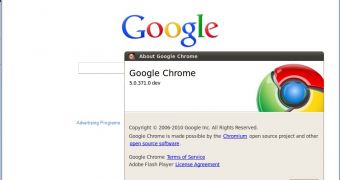Google's approach to software development, iterate fast and often, means that small, new features and updates creep in all the time. This is true for Google Chrome too, the developer build is updated almost once a week and the changes are rarely worth noticing. The latest update, though, Google Chrome 5.0.371.0 dev, brings a number of big, new features like geolocation, better WebGL support, preferences and theme sync, and plenty of other small changes.
One feature that was expected, yet still manages to surprise, is the greatly revamped sync system. Google Chrome has had bookmark sync support for several months now, enabling users to have one set of common bookmarks regardless of where they use Chrome and on what device. In the past couple of weeks, more sync capabilities started showing up in Chromium, the open-source project from which Chrome is derived. Now, just a couple of days after landing in Chromium, Google Chrome gets full preferences, auto-fill and theme-sync support. What's more, theme sync wasn't even available in Chromium a day before and was added to both browsers in the latest update.
Geolocation is now, finally, enabled by default in Google Chrome. The feature was introduced as an early implementation about a month ago, but it is now mature enough to be fully supported. What it means is that sites will be able to determine your current location, with your permission, and serve you different data based on that. This comes in especially handy on mobile devices and is one area expected to see a lot of growth along with the rise in mobile-web use. Firefox has had geolocation support since last summer with Firefox 3.5.
Native 3D graphics for the web are one step closer to becoming a reality with the improved WebGL support. WebGL is an emerging web standard and technology aimed at bringing hardware-accelerated 3D graphics rendering to HTML5-powered websites. The technology is still in active development, but is supported at various stages by modern web browsers like Chrome, Safari and Firefox. With Google Chrome 5.0.371.0 dev, WebGL now runs in sandbox mode on all platforms. WebGL support was built into Chrome, but, until now, testers had to run the browser with the --no-sandbox command line flag. Sandboxing is one of Chrome's best security features, as it keeps the web content and code isolated from the operating system's other components. WebGL is still not enabled by default in Chrome, so users have to add the --enable-webgl flag to test it.
Google Chrome 5.0.371.0 dev also comes with a number of UI tweaks focusing on the Omnibox. Users might have noticed some of them already, as they have been trickling in with previous versions, but Google says they are now all available. Tweaks include new icons for things like bookmarking web pages, secure HTTPS connections, and so on. Users will notice that HTTPS URLs no longer have a colored background, instead, the leading 'https' part of the URL is now blue. UPDATE: As Google's Peter Kasting points out in the comments, more changes to the Omnibox are coming.
Windows 7 users will also notice that Aero Peek, which was recently introduced, has now been disabled. Finally, the underlying technology powering Google Chrome has also been updated. The Webkit web rendering engine has been updated from r56820 to r57160 and the V8 JavaScript engine has been bumped to version 2.2.1.
Google Chrome 5.0.371.0 dev for Windows is available for download here. Google Chrome 5.0.371.0 dev for Mac is available for download here. Google Chrome 5.0.371.0 dev for Linux is available for download here.

 14 DAY TRIAL //
14 DAY TRIAL // 
